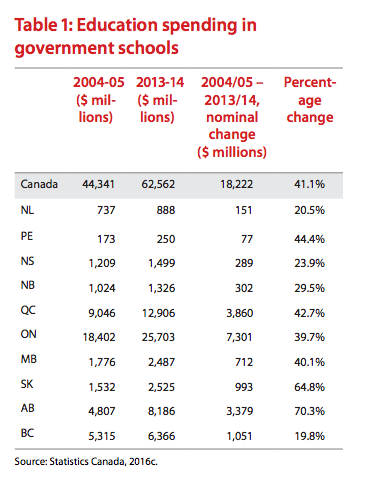B.C. government spending on public schools rose 20% to $6.3 billion between the 2004-2005 and 2013-2014 school years, according to the Fraser Institute, which released a report named Education Spending and Public Student Enrolment in Canada, 2016 Edition on September 1.
The 2013-2014 school year is the last one for which data is available, according to the free enterprise think tank.
“There’s a common misperception, perpetuated by teachers’ unions and activists, that spending on public schools in B.C. has been declining, but that simply is not true,” said Deani Van Pelt, who is director of the Fraser Institute’s Barbara Mitchell Centre for Improvement in Education and a co-author of the study.
During those nine years studied, the number of students in B.C. public schools declined 9.5%, the report noted.
On a per-student basis, Van Pelt calculated that spending increased to $11,797 from $9,971, after accounting for inflation, which the report pinned at 18.3% between 2004/2005 and 2013/2014.
The report then finds that spending on public schools in B.C. increased 14.6%, or nearly $1 billion, more than was necessary to account for declining enrolment and price changes.
“Contrary to what we hear from teachers, administrators and trustees, the public school system in B.C. has received large increases in funding over the last decade,” Van Pelt said.
Vancouver School Board trustee Patti Bacchus had not fully read the study but was skeptical that the finding is accurate.
“One of the things that I thought I saw in the Fraser Institute report was that they blended in capital funding with operating funding,” Bacchus said.
 She said that some groups of workers in B.C.’s education sector might have been “playing catch-up” when it came to raises because prior to the time period that the Fraser Institute studied because their wages had been falling behind.“
She said that some groups of workers in B.C.’s education sector might have been “playing catch-up” when it came to raises because prior to the time period that the Fraser Institute studied because their wages had been falling behind.“
We also have the doubling of MSP premiums, hydro costs at a much higher pace than any funding increase and there are a number of costs that school districts have had to take on that either used to be provincially funded or did not exist,” Bacchus said.
She mentioned insurance premiums as one example. That cost was previously paid by the province, according to Bacchus, and was then shifted to school districts.
Similarly, carbon offset costs are another new cost that school boards have to endure, she said.




